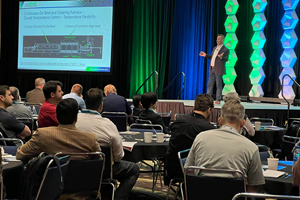Wayland Additive’s Calibur3 Features NeuBeam PBF Process
Formnext 2023: The company’s fully neutralized NeuBeam process for the Calibur3 metal additive manufacturing system solves the charging issues that have previously restricted electron beam melting processes.
Share
Read Next
Wayland Additive’s Calibur3 metal additive manufacturing (AM) system was developed to overcome common problems with metal AM and deliver on all of the advantages of metal electron beam (eBeam) powder bed fusion (PBF) technology.
The company’s fully neutralized NeuBeam process for the Calibur3 solves the charging issues that have, until now, restricted EBM processes. The open nature of this metal AM system also offers the ability to process a wider palette of metal materials.
“As we champion the wider adoption of metal AM throughout industry, our focus on extending the material range available to companies is fundamental,” says Will Richardson, Wayland CEO. “NeuBeam unlocks a swathe of complex metal production opportunities that current metal AM processes struggle with. This is because the process is compatible with a much wider range of metal powders, including but not limited to refractory metals and highly reflective alloys.”
NeuBeam has the ability to process existing metal materials, which reduces the difficulities related to qualifying new parts. The fact that NeuBeam achieves full charge neutralization during the build process is the key to offering superior metallurgical capabilities, and opens up the choice of a wider palette of materials for metal AM.
The process also eliminates issues concerning residual stress typical with alternative metal AM processes, and produces fully dense parts with demonstrably greater internal integrity. NeuBeam also removes the need for an entire sinter cake around the parts, which requires costly and time-consuming postprocessing steps that can negate the benefits of AM for a given application. This is achieved by only applying the required high temperatures to the part being built, rather than the entire powder bed.
“The elimination of residual stresses is a huge opportunity for the accelerated uptake of metal AM across a whole array of industry applications,” Richardson adds. “It is fundamentally because of the fact that the process is what we call a ‘hot part’ rather than a ‘hot bed’ process. This means that the high processing temperatures required are applied to the part, not the bed, and this ensures free-flowing powder post-build (no sinter cake) and stress-free parts with reduced energy consumption.”
Examples include intricate large parts made from titanium (which when processed using NeuBeam require no postprocess heat treatment); carbon steels (the NeuBeam process enabling the printing of alloys with higher carbon contents that would otherwise crack when printed using existing laser PBF techniques); and fully dense parts in Tungsten (a refractory metal that requires exceptionally high temperatures to melt and which his prone to cracking in any other metal AM process). The capabilities of NeuBeam means that users can tackle a much broader spectrum of metal materials and develop them for Calibur3, and can do it rapidly.
The core feature of the Calibur3 system is in its neutralizing the unstable nature of the eBeam process, an issue that Wayland says it has fully resolved. In addition, Calibur3 is modular in design with a well-thought-out user interface that is easy to use. The machine is also supplied with a Depowdering and Recycling (DPR) unit.
- Learn more about Wayland Additive’s Calibur3 for geometrically complex metal parts. The NeuBeam technology is a hot part process rather than a hot bed process. That means it can efficiently create parts that are free of residual stresses because the high temperatures are only applied to the part and not the bed.
- Read about NeuBeam 3D printing process for electron beam melting which overcomes the challenges in bringing new materials and capabilities to EBM metal 3D printing.
Related Content
AMT’s PostPro Pure Offers Sustainable Vapor Smoothing Chemistry
Formnext 2022: This FDA-approved chemistry offers a green approach for vapor smoothing 3D printed parts.
Read MoreThe Additive Manufacturing Conference Is Becoming the Formnext Forum
The 2023 Formnext Forum takes place in Austin, Texas, and absorbs the event previously known as the Additive Manufacturing Conference.
Read More10 Important Developments in Additive Manufacturing Seen at Formnext 2022 (Includes Video)
The leading trade show dedicated to the advance of industrial 3D printing returned to the scale and energy not seen since before the pandemic. More ceramics, fewer supports structures and finding opportunities in wavelengths — these are just some of the AM advances notable at the show this year.
Read More10 Video Reports From Formnext 2023
Our Formnext video playlist: Stephanie Hendrixson and Peter Zelinski report on various technologies seen at Formnext 2023 in brief videos they filmed at the show.
Read MoreRead Next
Hybrid Additive Manufacturing Machine Tools Continue to Make Gains (Includes Video)
The hybrid machine tool is an idea that continues to advance. Two important developments of recent years expand the possibilities for this platform.
Read More4 Ways the Education and Training Challenge Is Different for Additive Manufacturing
The advance of additive manufacturing means we need more professionals educated in AM technology.
Read More3D Printing Brings Sustainability, Accessibility to Glass Manufacturing
Australian startup Maple Glass Printing has developed a process for extruding glass into artwork, lab implements and architectural elements. Along the way, the company has also found more efficient ways of recycling this material.
Read More






















